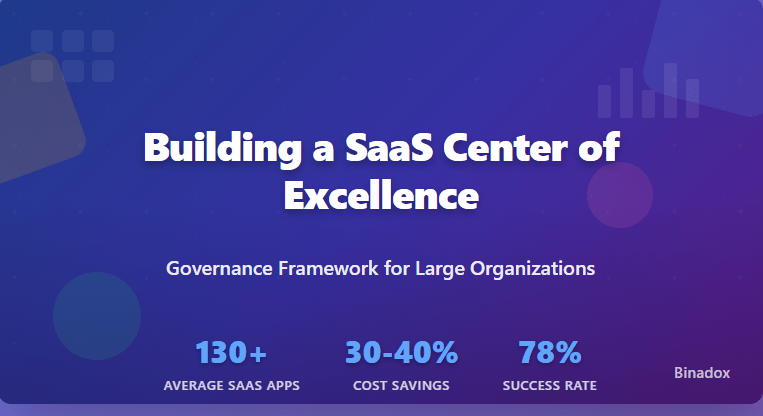
Large organizations today face an unprecedented challenge in managing their rapidly expanding SaaS ecosystems. With the average enterprise using over 130 SaaS applications and spending millions annually on software subscriptions, the need for structured governance has never been more critical. A SaaS Center of Excellence (CoE) provides the framework, processes, and oversight necessary to transform chaotic SaaS sprawl into a strategic advantage.
This comprehensive guide explores how to build and implement a robust SaaS governance framework that enables large organizations to maximize their software investments while minimizing risks. From establishing foundational processes to implementing affordable SaaS solutions and best SaaS cost trackers, we’ll cover the essential elements needed to create a successful SaaS Center of Excellence.
The journey toward effective SaaS governance begins with understanding that software as a service isn’t just a technology decision—it’s a business transformation that requires dedicated oversight, clear policies, and the right tools to ensure benefits of SaaS optimization are fully realized across the organization.
What is a SaaS Center of Excellence?
A SaaS Center of Excellence is a centralized organizational unit that provides leadership, governance, and expertise for all Software as a Service initiatives within an enterprise. Unlike traditional IT governance models that focus primarily on infrastructure and security, a SaaS CoE addresses the unique challenges of managing subscription-based software across multiple departments, geographies, and use cases.
The primary mission of a SaaS CoE extends beyond simple cost management. It encompasses strategic alignment of SaaS solutions with business objectives, risk mitigation, vendor relationship management, and the establishment of best practices that enable scalable software adoption. This centralized approach ensures that organizations can leverage the full potential of their SaaS investments while maintaining control and visibility.
At its core, a SaaS Center of Excellence serves as the bridge between business units seeking agile software solutions and IT departments responsible for security, compliance, and cost control. This cross-functional approach is essential for modern enterprises where business users increasingly drive software selection and adoption, often bypassing traditional IT procurement processes.
The CoE model recognizes that effective SaaS governance requires both technical expertise and business acumen. Teams within the center typically include professionals with backgrounds in IT management, finance, procurement, security, and business operations. This diverse skill set enables comprehensive oversight of the entire SaaS lifecycle, from initial evaluation and procurement to ongoing optimization and eventual retirement.
Key functions of a SaaS CoE include establishing vendor evaluation criteria, managing contract negotiations, implementing automated SaaS tracking systems, and providing ongoing education and support to business users. The center also serves as the primary point of contact for SaaS vendors, streamlining communication and ensuring consistent messaging across the organization.
Why Large Organizations Need SaaS Governance
The exponential growth of SaaS adoption in large organizations has created a perfect storm of complexity that traditional IT governance models struggle to address. Without proper oversight, organizations find themselves grappling with shadow IT, redundant applications, security vulnerabilities, and spiraling costs that can quickly reach millions of dollars annually.
Shadow IT represents one of the most significant challenges facing large organizations today. Business units, empowered by simple procurement processes and corporate credit cards, often subscribe to affordable SaaS platforms without involving IT departments. While this agility enables rapid deployment and innovation, it creates blind spots in security, compliance, and cost management that can have serious consequences.
The financial implications of uncontrolled SaaS growth are staggering. Organizations commonly discover they’re paying for multiple tools that perform identical functions, maintain subscriptions for departed employees, or operate under enterprise agreements that far exceed actual usage requirements. These inefficiencies can result in 30-40% overspending on SaaS applications, representing millions in wasted budget for large enterprises.
Security and compliance risks multiply exponentially with each new SaaS application added to the environment. Each tool potentially introduces new attack vectors, data storage locations, and regulatory obligations. Without centralized oversight, organizations struggle to maintain consistent security standards, monitor data flows, or ensure compliance with industry regulations and privacy laws.
Vendor proliferation creates additional complexity in contract management, renewal negotiations, and relationship oversight. Large organizations might maintain relationships with hundreds of SaaS vendors, each with different terms, renewal dates, and support requirements. This fragmentation makes it difficult to leverage purchasing power, negotiate favorable terms, or maintain consistent service levels across the technology stack.
The need for strategic alignment becomes critical as SaaS applications increasingly become core business systems. Without proper governance, organizations risk deploying conflicting solutions, creating data silos, or missing opportunities to leverage integrations and synergies between applications. A SaaS CoE ensures that technology decisions support broader business objectives and enable digital transformation initiatives.
Core Components of a SaaS CoE Framework
A comprehensive SaaS Center of Excellence framework encompasses several interconnected components that work together to provide holistic governance across the entire SaaS lifecycle. These components must be carefully designed and integrated to ensure maximum effectiveness while minimizing operational overhead.
Governance Structure and Leadership
The foundation of any successful SaaS CoE lies in establishing clear governance structure and leadership accountability. This typically involves creating a steering committee composed of senior stakeholders from IT, finance, procurement, legal, and key business units. The steering committee provides strategic direction, approves policies, and ensures alignment with broader organizational objectives.
Executive sponsorship is crucial for SaaS CoE success, as the center must have sufficient authority to enforce policies and drive compliance across diverse business units. The executive sponsor, typically a CIO or CDO, champions the CoE initiative and provides the political capital necessary to overcome resistance and drive adoption of new processes.
Operational leadership is usually provided by a SaaS CoE director or manager who oversees day-to-day activities, manages the CoE team, and serves as the primary interface between the center and business stakeholders. This role requires a unique blend of technical expertise, business acumen, and change management skills to navigate the complex dynamics of large organization software governance.
Policy and Standards Framework
Comprehensive policies and standards form the operational backbone of SaaS governance, providing clear guidelines for application evaluation, procurement, deployment, and management. These policies must balance the need for control with the agility that makes SaaS attractive to business users.
The application evaluation framework establishes criteria for assessing potential SaaS solutions across multiple dimensions including functionality, security, compliance, integration capabilities, vendor stability, and total cost of ownership. This framework ensures consistent evaluation processes while enabling business units to make informed decisions about software investments.
Procurement standards define the processes for acquiring SaaS applications, including approval workflows, contract review requirements, and vendor onboarding procedures. These standards help organizations leverage purchasing power, ensure consistent terms and conditions, and maintain visibility into all software expenditures.
Security and compliance policies establish minimum requirements for data protection, access controls, audit capabilities, and regulatory compliance. These policies must be specific enough to provide clear guidance while remaining flexible enough to accommodate the diverse security models employed by different SaaS vendors.
Technology Infrastructure and Tools
Modern SaaS management platforms provide the technological foundation for effective governance, offering visibility, control, and automation capabilities that would be impossible to achieve through manual processes alone. These platforms serve as the central nervous system for SaaS operations, providing real-time insights into application usage, costs, and performance.
Discovery and inventory tools automatically identify SaaS applications in use across the organization, including shadow IT deployments that might otherwise remain invisible. These tools typically integrate with network monitoring systems, expense management platforms, and identity providers to create comprehensive application inventories.
Cost management and optimization tools provide detailed analytics on SaaS spending, utilization rates, and optimization opportunities. Advanced platforms offer automated SaaS tracking capabilities that monitor usage patterns, identify unused licenses, and recommend right-sizing opportunities to optimize costs and improve efficiency.
Identity and access management integration ensures that user provisioning, deprovisioning, and access controls are consistently applied across all SaaS applications. This integration is crucial for maintaining security standards and ensuring compliance with access governance requirements.
Process Framework
Standardized processes ensure consistent execution of SaaS governance activities while providing clear guidance for business stakeholders navigating the software lifecycle. These processes must be designed to minimize friction while ensuring appropriate oversight and control.
The application request and approval process provides a structured approach for business units to request new SaaS applications or modifications to existing subscriptions. This process typically includes business case development, security review, vendor evaluation, and contract negotiation phases.
Vendor management processes govern relationships with SaaS providers throughout the entire lifecycle, from initial evaluation through contract renewal or termination. These processes ensure consistent communication, performance monitoring, and relationship optimization across all vendor relationships.
Change management processes address the unique challenges of managing software updates, configuration changes, and new feature deployments in SaaS environments. Unlike traditional software where organizations control update timing, SaaS applications are continuously updated by vendors, requiring proactive change management approaches.
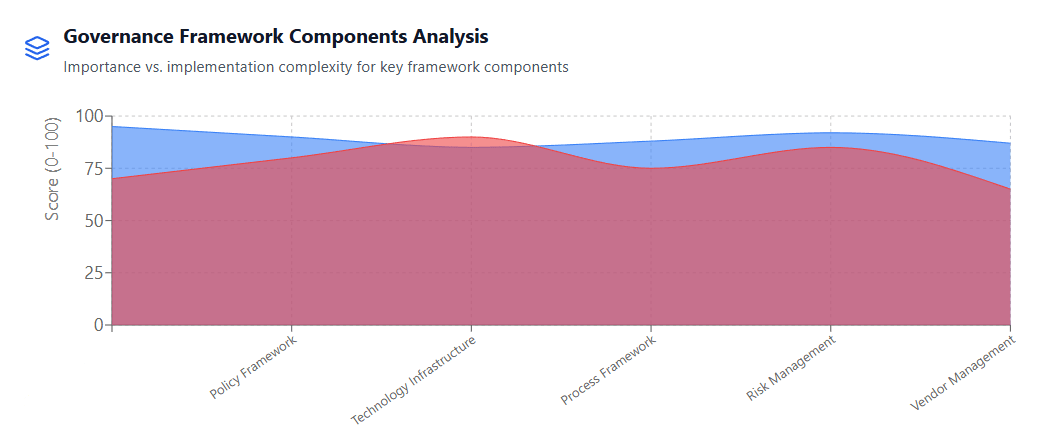
Establishing Your SaaS Center of Excellence
Creating a SaaS Center of Excellence requires careful planning, stakeholder alignment, and phased implementation to ensure successful adoption and long-term sustainability. The establishment process typically spans 6-12 months and involves multiple parallel workstreams focused on organizational design, process development, and technology implementation.
Phase 1: Foundation and Assessment
The journey begins with conducting a comprehensive assessment of the current SaaS landscape, including application inventory, spending analysis, and governance maturity evaluation. This assessment provides the baseline understanding necessary to design an effective CoE framework and establish success metrics.
Current state analysis involves cataloging all known SaaS applications, analyzing spending patterns, identifying redundancies, and assessing security and compliance gaps. This analysis often reveals significant opportunities for cost saving and risk reduction that can be used to justify CoE investment and demonstrate early wins.
Stakeholder mapping and engagement is crucial during this phase, as successful SaaS governance requires buy-in from diverse business units and functional areas. Key stakeholders typically include business unit leaders, IT leadership, finance teams, procurement professionals, legal counsel, and security specialists.
Governance maturity assessment evaluates the organization’s current capabilities in areas such as vendor management, contract administration, security oversight, and cost control. This assessment helps identify capability gaps and prioritize development efforts.
Phase 2: Framework Design and Team Formation
The second phase focuses on designing the specific governance framework that will guide CoE operations and assembling the team responsible for implementing and operating the center. This phase requires careful attention to organizational dynamics and change management considerations.
Framework customization involves adapting general SaaS governance principles to fit the organization’s specific culture, risk tolerance, and operational requirements. This customization ensures that policies and processes will be practical and enforceable within the existing organizational context.
Team formation requires identifying and recruiting professionals with the diverse skill sets necessary for effective SaaS governance. The core team typically includes roles such as SaaS program manager, vendor relationship manager, financial analyst, security specialist, and business analyst.
Technology platform selection involves evaluating and implementing the tools necessary to support CoE operations. This typically includes SaaS management platforms, contract management systems, and integration with existing IT service management and financial systems.
Phase 3: Implementation and Rollout
The final phase involves implementing the governance framework, training stakeholders, and beginning operations. This phase requires careful change management to ensure adoption and minimize disruption to ongoing business operations.
Pilot program implementation allows the CoE to test processes and tools with a limited set of applications and stakeholders before full-scale rollout. This pilot approach enables refinement of processes and identification of potential issues before they impact the broader organization.
Training and education programs ensure that business stakeholders understand new processes and requirements while highlighting the benefits of improved SaaS governance. These programs must be tailored to different audiences and delivered through multiple channels to ensure maximum effectiveness.
Communication and change management activities build awareness and support for the CoE initiative while addressing concerns and resistance from stakeholders. Effective communication emphasizes the benefits of improved governance rather than focusing solely on new requirements and restrictions.
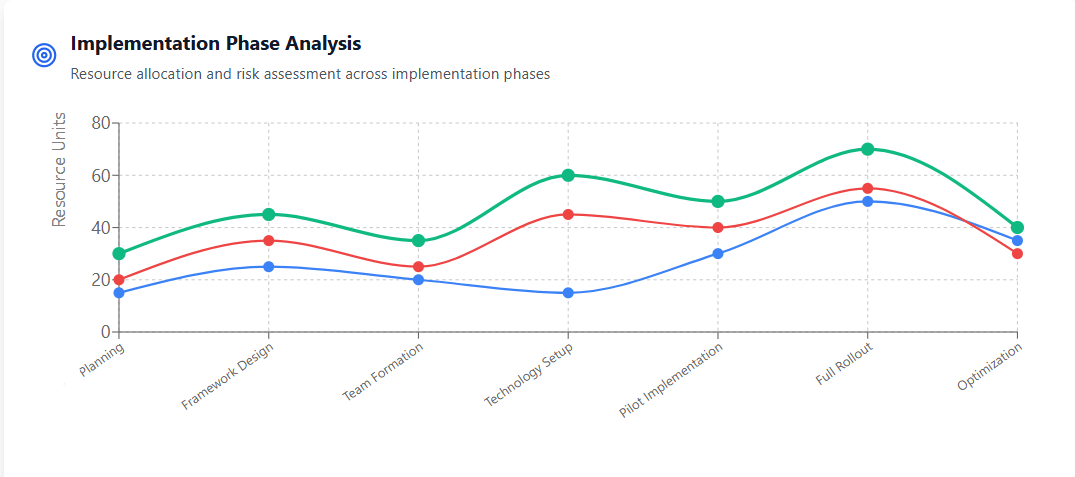
SaaS Governance Best Practices for Large Organizations
Successful SaaS governance in large organizations requires adherence to proven best practices that have been refined through experience across diverse industry sectors and organizational structures. These practices provide a framework for avoiding common pitfalls while maximizing the value derived from SaaS investments.
Centralized Procurement with Distributed Decision-Making
Effective SaaS governance balances the need for centralized control with the agility requirements that drive SaaS adoption. The most successful organizations implement models that centralize procurement processes and vendor management while enabling distributed decision-making for application selection and usage.
Centralized procurement ensures consistent contract terms, leverages organizational purchasing power, and maintains visibility into all software expenditures. However, overly rigid centralization can stifle innovation and slow business operations. The key is creating streamlined approval processes that provide rapid decision-making for standard applications while requiring additional review for high-risk or high-cost solutions.
Affordable SaaS solutions can often be approved through automated workflows that check against pre-approved vendor lists and security requirements. More complex enterprise solutions require additional review and approval steps but should still be processed efficiently to avoid business disruption.
Risk-Based Approach to Security and Compliance
Large organizations must balance security requirements with business agility, particularly when dealing with the diverse security models employed by different SaaS vendors. A risk-based approach enables appropriate security controls without unnecessarily restricting business operations.
Application classification systems categorize SaaS applications based on data sensitivity, business criticality, and regulatory requirements. This classification drives different levels of security review and ongoing monitoring, ensuring that resources are focused on the highest-risk applications.
Vendor security assessment processes should be proportional to application risk levels while maintaining consistent minimum standards. High-risk applications require comprehensive security reviews, while lower-risk tools can be evaluated using standardized questionnaires and automated assessment tools.
Continuous Optimization and Performance Management
SaaS governance is not a “set it and forget it” activity but requires ongoing attention to optimization opportunities and performance management. Leading organizations implement continuous improvement processes that regularly evaluate and enhance their SaaS portfolios.
Regular portfolio reviews analyze application performance, user satisfaction, cost trends, and strategic alignment to identify optimization opportunities. These reviews often reveal applications that are underutilized, redundant, or no longer aligned with business needs.
Benefits of SaaS optimization extend beyond simple cost reduction to include improved user experience, enhanced security posture, and better strategic alignment. Organizations that invest in ongoing optimization typically achieve 20-30% cost savings while improving overall SaaS portfolio performance.
Data-Driven Decision Making
Effective SaaS governance relies on comprehensive data and analytics to guide decision-making and measure success. Organizations must implement robust measurement and reporting capabilities that provide visibility into all aspects of SaaS performance.
Usage analytics provide insights into how applications are actually being used, identifying optimization opportunities and informing license right-sizing decisions. These analytics can reveal significant discrepancies between purchased licenses and actual usage, enabling substantial cost optimization.
Financial analytics track spending trends, forecast future costs, and identify budget variances that require attention. Advanced analytics can predict renewal costs, identify potential vendor consolidation opportunities, and optimize contract timing to maximize negotiating leverage.
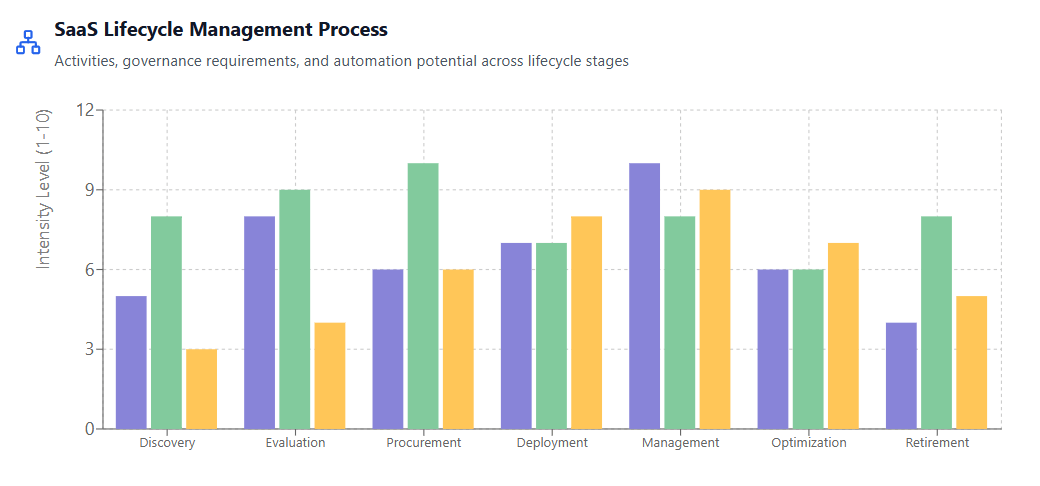
Technology Stack for SaaS Management
The technological foundation of a SaaS Center of Excellence consists of integrated platforms and tools that provide the visibility, control, and automation capabilities necessary for effective governance at scale. These technologies must work together seamlessly to create a comprehensive view of the SaaS environment while enabling efficient operations.
SaaS Management Platforms
Modern SaaS management platforms serve as the central hub for CoE operations, providing comprehensive visibility into application usage, costs, and performance. These platforms typically offer discovery capabilities that automatically identify SaaS applications through multiple methods including network traffic analysis, expense system integration, and identity provider logs.
Leading platforms provide sophisticated analytics that reveal usage patterns, identify optimization opportunities, and track key performance indicators. These insights enable data-driven decision-making and continuous optimization of the SaaS portfolio.
Integration capabilities are crucial for SaaS management platforms, as they must connect with existing IT systems including identity providers, financial systems, and IT service management platforms. This integration enables automated workflows and ensures that SaaS governance processes align with broader IT operations.
Binadox exemplifies the type of comprehensive SaaS management platform that large organizations require, offering discovery, cost optimization, and governance capabilities in a single integrated solution. The platform provides the visibility and control necessary for effective SaaS governance while supporting the scalability requirements of large enterprises.
Identity and Access Management Integration
Identity and access management (IAM) integration is essential for maintaining security and compliance across the SaaS portfolio. This integration ensures consistent access controls, enables automated provisioning and deprovisioning, and provides audit capabilities for regulatory compliance.
Single sign-on (SSO) implementation standardizes authentication across all SaaS applications while providing centralized control over user access. SSO integration also enables better usage tracking and security monitoring by providing a centralized view of user activities.
Automated provisioning workflows ensure that new users are granted appropriate access to required applications while maintaining security standards. Similarly, automated deprovisioning ensures that access is promptly removed when users change roles or leave the organization.
Contract and Vendor Management Systems
Dedicated contract and vendor management systems provide the specialized capabilities necessary for managing the complex contractual relationships that characterize SaaS environments. These systems must handle the unique aspects of subscription-based contracts including usage-based pricing, automatic renewals, and frequent term modifications.
Contract lifecycle management features support the entire contracting process from initial negotiation through renewal or termination. These features include approval workflows, template management, and integration with procurement and financial systems.
Vendor performance monitoring capabilities track key metrics such as uptime, support responsiveness, and user satisfaction to ensure that SaaS providers are meeting their contractual obligations. This monitoring provides the data necessary for effective vendor relationship management and contract renewal negotiations.
Financial Management and Analytics Tools
Sophisticated financial management tools are necessary to track, analyze, and optimize SaaS spending across large, complex organizations. These tools must provide visibility into spending patterns, forecast future costs, and identify optimization opportunities.
Cost allocation capabilities enable accurate tracking of SaaS expenses by department, project, or cost center, supporting chargeback models and budget accountability. This allocation is particularly important for large organizations where SaaS costs can be substantial and must be properly attributed.
Predictive analytics help organizations forecast future SaaS spending, identify potential budget overruns, and optimize contract timing. These capabilities are essential for effective financial planning and cost management.
Measuring Success: KPIs and Metrics
Establishing clear success metrics is crucial for demonstrating the value of SaaS governance initiatives and identifying areas for continuous improvement. These metrics must align with organizational objectives while providing actionable insights that drive better decision-making.
Financial Performance Metrics
Cost optimization metrics provide the most visible demonstration of SaaS governance value, tracking savings achieved through various optimization initiatives. These metrics typically include absolute cost savings, cost avoidance through better vendor negotiations, and efficiency improvements through application consolidation.
Spend visibility improvements can be measured through metrics such as the percentage of SaaS spending under management, reduction in shadow IT expenditures, and improvement in budget forecast accuracy. These metrics demonstrate the CoE’s impact on financial control and planning.
Return on investment calculations should account for both direct cost savings and operational efficiency improvements. The most comprehensive ROI analyses include soft benefits such as improved security posture, reduced compliance risk, and enhanced business agility.
Operational Efficiency Metrics
Process efficiency metrics track improvements in SaaS-related activities such as application procurement time, vendor onboarding duration, and contract renewal cycle time. These metrics demonstrate the CoE’s impact on operational effectiveness and business agility.
Risk reduction metrics measure improvements in security posture, compliance status, and vendor management effectiveness. These metrics might include the percentage of applications meeting security standards, compliance audit findings, and vendor performance scores.
User satisfaction metrics track stakeholder perception of SaaS governance processes and outcomes. High user satisfaction scores indicate that governance processes are effectively balancing control requirements with business needs.
Strategic Alignment Metrics
Portfolio optimization metrics measure progress toward strategic SaaS portfolio goals such as vendor consolidation, standardization on preferred platforms, and elimination of redundant applications. These metrics demonstrate the CoE’s contribution to broader digital transformation initiatives.
Innovation enablement metrics track the CoE’s impact on the organization’s ability to adopt new technologies and capabilities. These might include metrics such as time to deploy new SaaS solutions, percentage of applications integrated with existing systems, and business unit satisfaction with governance processes.
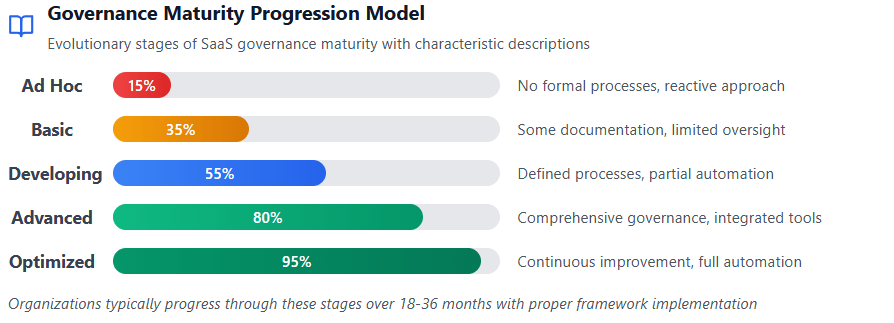
Common Challenges and Solutions
Large organizations implementing SaaS governance programs face predictable challenges that can be mitigated through proactive planning and proven strategies. Understanding these challenges enables better preparation and more successful outcomes.
Resistance to Change
Change resistance is perhaps the most significant challenge facing SaaS CoE initiatives, as new governance processes often require business units to modify established practices and accept additional oversight. This resistance can manifest as non-compliance with new processes, attempts to circumvent governance controls, or passive resistance through minimal participation.
Successful change management requires clear communication about the benefits of improved governance, including enhanced security, cost optimization, and better vendor relationships. Stakeholders must understand how governance processes will improve their ability to achieve business objectives rather than simply adding bureaucratic overhead.
Executive sponsorship is crucial for overcoming resistance, as senior leadership must consistently reinforce the importance of SaaS governance and hold business units accountable for compliance. This sponsorship must be visible and consistent throughout the implementation process.
Balancing Control and Agility
Finding the right balance between governance control and business agility represents an ongoing challenge for SaaS CoE teams. Overly rigid processes can stifle innovation and slow business operations, while insufficient control can lead to security risks and cost overruns.
Risk-based governance approaches provide a framework for tailoring control levels to specific situations and applications. Low-risk affordable SaaS platforms can be approved through streamlined processes, while high-risk or high-cost solutions require more comprehensive review and approval procedures.
Continuous process refinement based on feedback and performance metrics enables organizations to optimize this balance over time. Regular review and adjustment of governance processes ensures they remain aligned with business needs and objectives.
Technology Integration Complexity
Integrating SaaS governance tools with existing IT systems can present significant technical challenges, particularly in large organizations with complex, heterogeneous technology environments. These integration challenges can delay implementation and reduce the effectiveness of governance processes.
Phased implementation approaches can help manage integration complexity by focusing on critical integrations first while deferring less essential connections. This approach enables faster time to value while allowing for more thoughtful planning of complex integrations.
Vendor selection should prioritize platforms with robust integration capabilities and proven track records in large enterprise environments. Investment in integration capabilities typically pays dividends through improved efficiency and reduced manual effort.
Scaling Governance Across Global Organizations
Large multinational organizations face additional challenges in implementing consistent SaaS governance across diverse geographic regions, regulatory environments, and organizational cultures. These challenges require careful consideration of local requirements while maintaining global consistency where possible.
Regional adaptation of governance frameworks allows for accommodation of local regulatory requirements, cultural differences, and operational practices while maintaining consistency in core areas such as security and vendor management.
Technology platforms must support multi-currency, multi-language, and multi-timezone operations to effectively serve global organizations. This support is essential for maintaining consistent governance across diverse operating environments.
Future-Proofing Your SaaS CoE
The rapidly evolving SaaS landscape requires governance frameworks that can adapt to new technologies, business models, and organizational requirements. Future-proofing SaaS CoE initiatives ensures long-term sustainability and continued value delivery.
Emerging Technology Integration
Artificial intelligence and machine learning technologies are increasingly being integrated into SaaS management platforms, offering enhanced capabilities for application discovery, usage optimization, and risk assessment. CoE frameworks must be designed to accommodate these evolving capabilities while maintaining appropriate human oversight.
Automated SaaS tracking capabilities will continue to evolve, providing more sophisticated insights into application usage and optimization opportunities. Organizations should ensure their governance frameworks can accommodate increased automation while maintaining necessary controls and approvals.
Evolution of SaaS Business Models
The SaaS industry continues to evolve with new pricing models, delivery mechanisms, and service offerings that may require adjustments to governance frameworks. Usage-based pricing, outcome-based contracts, and platform ecosystem models all present unique governance challenges and opportunities.
Governance frameworks must be flexible enough to accommodate new business models while maintaining consistent risk management and cost control principles. This flexibility requires ongoing monitoring of industry trends and proactive framework updates.
Organizational Transformation
As organizations continue their digital transformation journeys, the role and scope of SaaS governance will likely expand to encompass broader technology governance responsibilities. CoE frameworks should be designed to support this evolution while maintaining their core focus on SaaS-specific challenges.
The integration of cloud computing and SaaS governance represents a natural evolution that many organizations are pursuing. Combined governance approaches can provide comprehensive oversight of both infrastructure and application services while eliminating organizational silos.
Conclusion
Building a successful SaaS Center of Excellence represents one of the most impactful investments large organizations can make in their digital transformation journey. The framework outlined in this guide provides a comprehensive approach to establishing governance that balances control with agility while delivering measurable value through cost optimization, risk reduction, and operational efficiency.
The key to successful SaaS governance lies in understanding that it’s not simply an IT initiative but a business transformation that requires cross-functional collaboration, executive sponsorship, and ongoing adaptation to changing needs. Organizations that approach SaaS governance strategically, with proper planning and stakeholder engagement, typically achieve significant returns on their investment while positioning themselves for continued success in an increasingly digital business environment.
The journey toward effective SaaS governance is challenging but rewarding, requiring dedication, resources, and patience to achieve full benefits. However, organizations that successfully implement comprehensive governance frameworks find themselves better positioned to leverage the full potential of their SaaS investments while minimizing risks and costs.
As the SaaS landscape continues to evolve, the importance of structured governance will only increase. Organizations that establish robust Centers of Excellence today will have a significant advantage in navigating future challenges and opportunities in the software-as-a-service ecosystem. The framework and best practices outlined in this guide provide a solid foundation for building governance capabilities that will serve organizations well into the future.
Through careful implementation of comprehensive governance frameworks, supported by appropriate technology platforms and guided by proven best practices, large organizations can transform their SaaS environments from sources of complexity and cost into strategic assets that drive business value and competitive advantage. The investment in SaaS governance pays dividends through improved cost control, reduced risk, and enhanced business agility that enables organizations to thrive in the digital economy.

